Corsair Obsidian 350D Case Review
by Dustin Sklavos on April 25, 2013 11:00 AM EST- Posted in
- Cases/Cooling/PSUs
- Corsair
- MicroATX
Noise and Thermal Testing
If the noise and thermal testing bordered on being academic for the Fractal Design Define Mini, it's even more out of place with the Corsair Obsidian 350D. The Define Mini lends itself well to liquid cooling, but the 350D was outright designed for it, and that substantially reduces the importance of air cooling performance. As a result, our conventional testing isn't just beneath the 350D's pay grade, it's not even at the same place of business.
With all that said, though, there are still a few things to learn here. Remember that the 350D starts at $99, making it an affordable enough starting point for the end user who just wants a classy, easy-to-build chassis.
Ambient temperature during testing was around 22C.


Thermally the Obsidian 350D puts in a fairly healthy performance. Competitive without being spectacular, it mostly suffers from being an offshoot of the basic ATX case design. Air cooling thermals have never been Corsair's strong suit, but they've always been workable, and the 350D continues that trend.
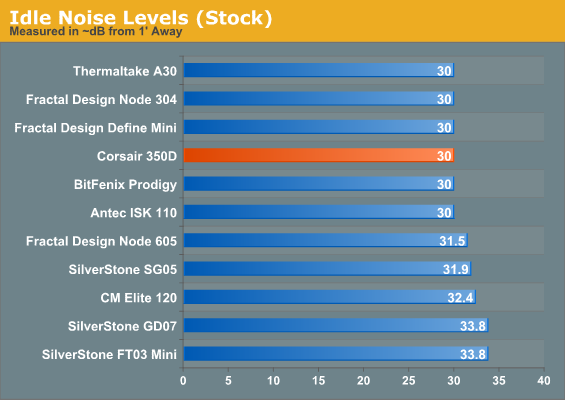
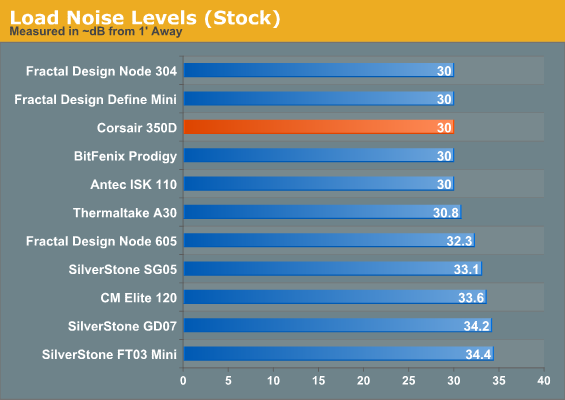
Because the 350D is able to keep thermals reasonably low, noise stays low as well. The vanilla testbed is nowhere near stressful enough to really work the 350D.
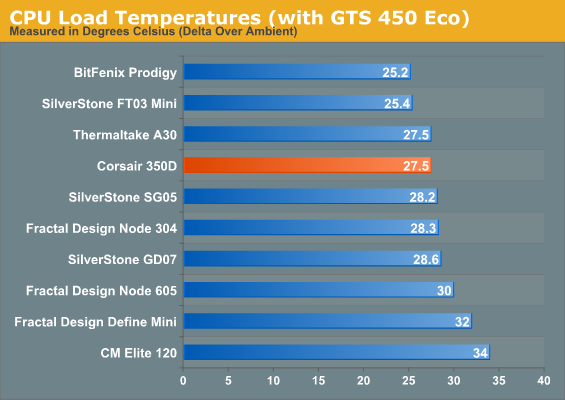
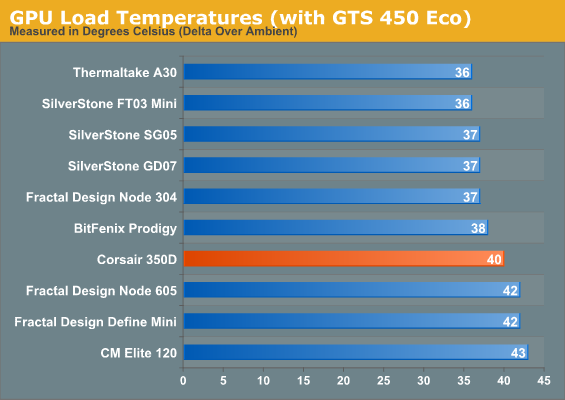

When you add even a modest dedicated graphics card, Corsair starts playing that old familiar song. The plastic "cage" used for the SSD doesn't seem to be particularly detrimental to its temperatures, but even the direct airflow from the front fan onto the GTS 450 Eco isn't really adequate. CPU thermals remain solid, though.
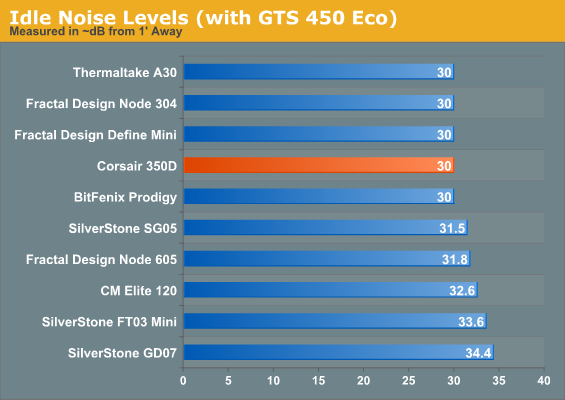
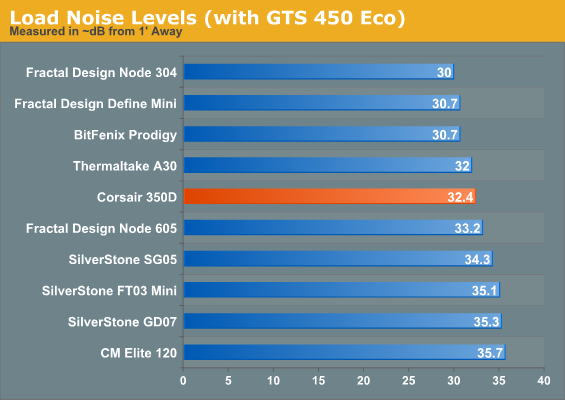
Idle noise continues to be a non-issue. Load noise isn't terrible, but it's not very impressive, either. While Fractal Design's case has a lot of acoustic padding and is built with heavy steel to help insulate noise, the 350D has no such allowances, and noise becomes entirely dependent on the efficiency of the cooling system.
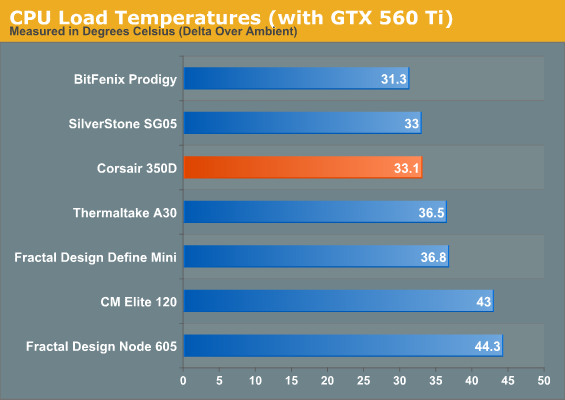

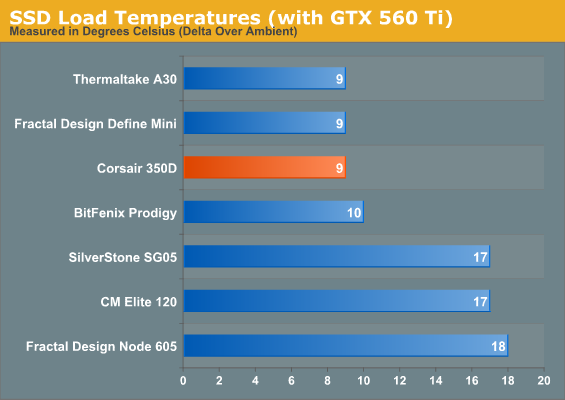
Adding a more robust video card only reinforces what we've already learned. CPU cooling performance is above average, but GPU cooling performance continues to be middling. These cards are using open air coolers that will tax the case's cooling system, and the middling stock cooling (one 140mm intake and one 120mm exhaust in their typical ATX locations) doesn't do the 350D any favors.
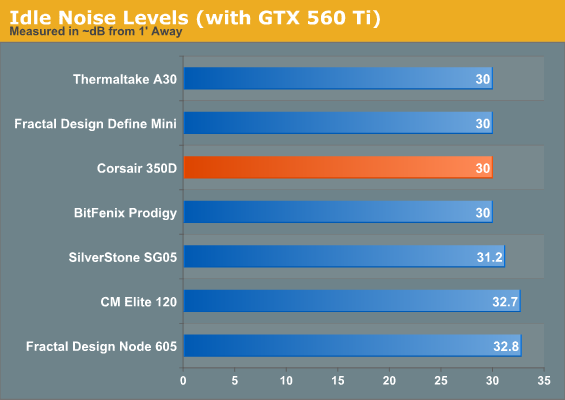

Noise levels are reasonable. The cooler on our GTX 560 Ti can be pretty rough on any enclosure (and is outright hostile when the 560 is overclocked), but at least the 350D isn't getting overwhelmed.










65 Comments
View All Comments
geniekid - Thursday, April 25, 2013 - link
I would've liked to see an option for a side fan. In my experience I've found that a side exhaust fan has a tremendous impact on temps when dealing with graphics cards that exhaust into the case.marc1000 - Thursday, April 25, 2013 - link
I also would have liked a side fan near the GPU. I don't care much about windows, but nothing is ever perfect to everyone. This case is better than the average mATX, even if not exactly small as it could be. nice review!AssBall - Friday, April 26, 2013 - link
If you are building a micro ATX board system with 400W gaming card(s), then you should probably re-evaluate your priorities.lmcd - Friday, April 26, 2013 - link
FYI LAN parties and LAN cases are both still relatively popular.Death666Angel - Saturday, May 11, 2013 - link
No? If it's possible, why not? mATX doesn't mean "less powerful" it just means "smaller".EzioAs - Thursday, April 25, 2013 - link
Looking at the aesthetics, performance numbers and your comments on how easy it was to assemble inside it, I kinda guess you'd be giving it some kind of award.Personally, I think at this point in time we'd be getting 4xUSB 3.0 and the connectors are compatible with 3.0 and 2.0 like the ones in the Bitfenix Raider.
Other than that, fantastic looking case. Might be what I was looking for to put the old C2Q, 775 board and GTX460.
Thanks for the review Dustin.
lmcd - Friday, April 26, 2013 - link
Yeah, two USB 3 is getting low, especially with mobos now providing 2 USB 3 headers.rakunSA - Thursday, April 25, 2013 - link
First thing I noticed is that there's a bowl (a rice bowl perhaps?) in the reflection. HADustin Sklavos - Thursday, April 25, 2013 - link
I actually use rice bowls to hold screws. :)douglaswilliams - Thursday, April 25, 2013 - link
I first thought the bowl was inside the case, and that you were testing how long it took the case heat to cook the rice. It would certainly be a unique way to do thermal testing.